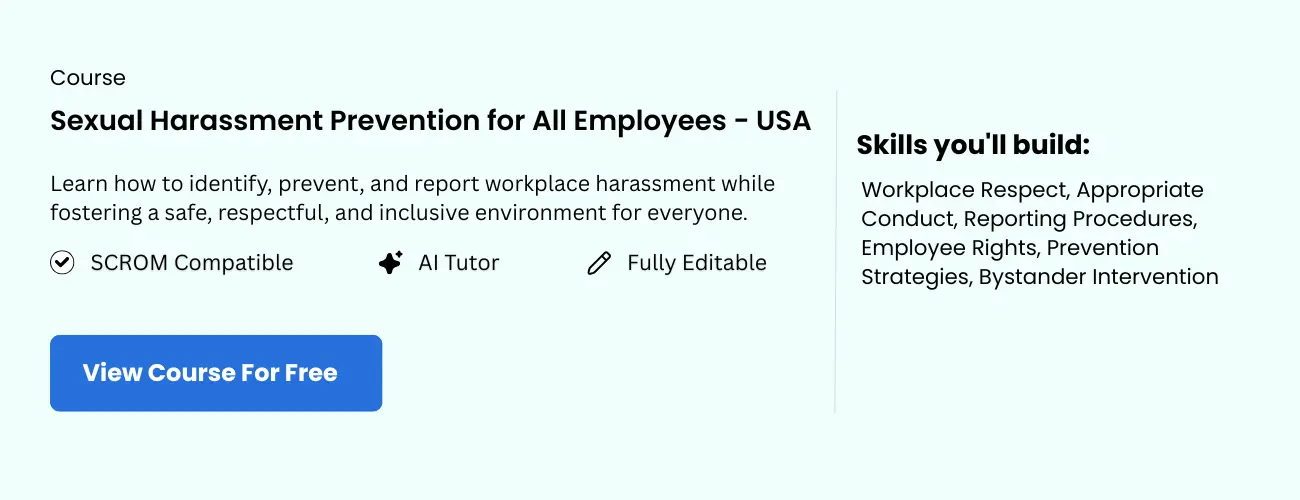Introduction to Sexual Harassment Training in New York
Sexual harassment remains a pervasive issue impacting workplaces across every industry, making prevention a critical priority for employers. Implementing comprehensive and ongoing training is not just a best practice it is a legal requirement in New York. The state’s evolving laws mandate structured learning programs that educate the workforce, reinforce accountability, and ensure Sexual Harassment Prevention for All Employees across diverse work settings.
New York’s regulations emphasize that prevention starts with awareness. This is why organizations must deliver clear, consistent, and practical guidance through Prevention of sexual harassment training for employees at all levels. Such training equips staff to recognize inappropriate behavior, understand reporting channels, and contribute to a safe, respectful, and compliant workplace culture. As expectations grow stricter each year, investing in strong sexual harassment prevention training becomes essential for reducing risks, safeguarding employee wellbeing, and building a workplace rooted in respect.
The Importance of Sexual Harassment Prevention
Preventing sexual harassment is both a legal and moral responsibility—especially in states like New York, where laws are among the strictest in the country. Organizations must provide New York sexual harassment prevention training annually, ensuring every employee understands their rights, protections, and responsibilities. Beyond compliance, prevention is essential for employee well-being, productivity, and maintaining a strong organizational reputation.
Effective training equips staff, supervisors, and leaders with the knowledge to recognize, address, and prevent misconduct early. With clear guidance rooted in NY State sexual harassment training standards, employees become more confident in identifying inappropriate behaviors and using proper reporting channels. This proactive approach not only reduces incidents but also safeguards the rights and dignity of everyone in the workplace.
The Role of Training in Workplace Safety
Training plays a central role in building workplaces that are safe, respectful, and free from discrimination. Through mandated NYC sexual harassment training requirements, employees learn what behaviors are prohibited, how to respond to uncomfortable situations, and how to report concerns without fear of retaliation.
Consistent education fosters a culture of respect, accountability, and inclusivity. When employees receive Sexual Harassment Prevention for All Employees programs tailored to New York’s legal framework, it reinforces the organization’s commitment to compliance and transparency. Regular training ensures ongoing awareness, supports positive workplace behaviors, and helps organizations stay aligned with evolving state and city regulations.
Legal Landscape and Recent Legislation in New York
New York has taken significant legal steps to combat workplace harassment. The 2019 amendments to the New York State Human Rights Law introduced mandatory anti-harassment training for workplaces with at least one employee. These laws aim to boost awareness, accountability, and safety.
Key Legislative Measures
The legislation emphasizes transparent policies, mandatory training, and swift response to complaints. It also addresses the need for ongoing education to adapt to changing legal standards and workplace dynamics.
Purpose and Scope of the Mandatory Training Requirement
Under New York law, employers must provide annual sexual harassment prevention training to all employees, including part-time, temporary, and seasonal staff. Training should clearly define harassment, outline reporting protocols, and detail procedures for addressing complaints.
Goals of the Training
This comprehensive approach aims to cultivate a respectful workplace culture, reduce harassment incidents, and ensure legal compliance. Training content must be accessible, informative, and tailored to diverse employee needs to meet higher standards of trust and safety.
New York’s Legal Requirements for Employers
Who Is Covered Under New York’s Employment Laws?
Coverage extends broadly to various employers and employees in New York, including:
- Private sector businesses of all sizes
- Public sector agencies and governmental bodies
- Part-time, seasonal, and temporary workers
- Employers of minors and vulnerable populations
Legal obligations may also extend to related anti-discrimination and equal employment opportunity laws, regardless of employer size.
Mandatory Training Content as per New York State Regulations
Required training must encompass:
- Sexual Harassment Prevention: Definitions, prohibited behaviors, reporting procedures, rights, and employer commitments.
- Disability and Accommodation: Rights under ADA and state laws, process for requesting accommodations, and accessibility standards.
- Workplace Safety Protocols: Hazard recognition, emergency procedures, and safe work practices.
- Workers’ Rights and Employer Responsibilities: Wage laws, anti-retaliation policies, and complaint procedures.
All content should be comprehensive, workplace-specific, and accessible in multiple languages to meet standards of expertise, authority, and trustworthiness.
Deadlines and Frequency of Required Training
Compliance deadlines include:
- Initial Training: Within 30 days of hire for all new employees.
- Annual Refreshers: At least once every 12 months to reinforce knowledge and update policies.
- Additional Sessions: During significant policy changes or after complaints.
Employers should retain records of training sessions—dates, attendees, and topics—to demonstrate compliance during audits or investigations.
Implementing Effective Sexual Harassment Training Programs
Developing impactful training programs promotes safety, compliance, and a respectful workplace. Best practices include engaging content, reputable resources, and strategic logistical planning.
Best Practices for Compliance and Effectiveness
Align training with legal standards like Title VII and state laws. Make content participatory—using scenarios, quizzes, and role-plays—to enhance retention and behavioral change. Regular updates reflect legal developments and organizational changes.
Strategies to Engage Employees
Use diverse delivery methods: in-person, online modules, microlearning. Ensure accessibility across devices. Encourage open discussions and anonymous reporting. Leadership involvement reinforces commitment and fosters accountability.
Resources and Certified Providers
Choose reputable providers such as Paradiso Course Catalog, Skillsoft, and ThinkHR. They offer customizable, up-to-date e-learning modules aligned with legal standards. Local HR consultants can tailor in-house training sessions. Verify that providers offer recognized certification and evidence of efficacy.
Costs and Logistical Considerations
Costs range from $20–$50 per employee for online courses and $1,000–$5,000 for in-person workshops, depending on organization size and scope. Online modules provide scalability, especially for remote teams. Scheduling should minimize disruption, with refresher courses at least annually to sustain awareness and compliance.
Key Takeaways and Next Steps for Employers
Creating a safe, respectful workplace is both a legal requirement and a moral imperative. Employers must develop clear policies, deliver effective training, and respond promptly to concerns. These measures foster trust and organizational integrity.
Employer Responsibilities
Employers should:
- Develop and communicate comprehensive anti-harassment policies
- Conduct mandatory, engaging training sessions
- Establish accessible channels for reporting misconduct
- Investigate complaints promptly and fairly
- Lead by example to promote respectful behavior
Consistent enforcement and regular policy reviews are essential to maintaining a harassment-free environment.
Benefits of Comprehensive Training
Effective harassment prevention reduces legal risks, boosts workplace morale, and enhances employee retention. Continuous training fosters a culture of respect, inclusivity, and transparency, leading to improved organizational performance.
Next Steps for Employers
To strengthen your harassment prevention efforts:
- Review and update policies regularly
- Implement mandatory, ongoing training programs
- Build a transparent reporting framework
- Ensure prompt, fair investigations
- Lead with commitment and accountability
Investing in these steps safeguards your organization legally and creates a positive, productive work environment where everyone feels respected and valued.













